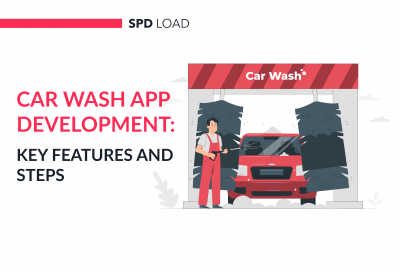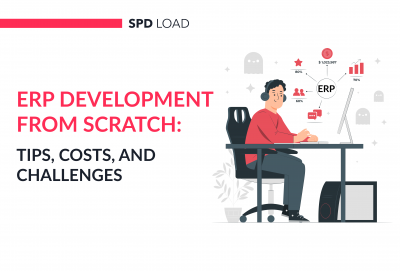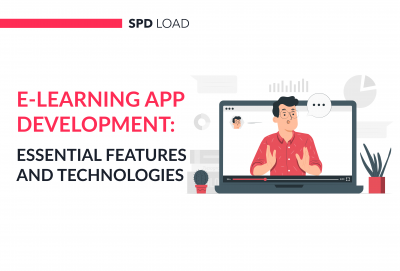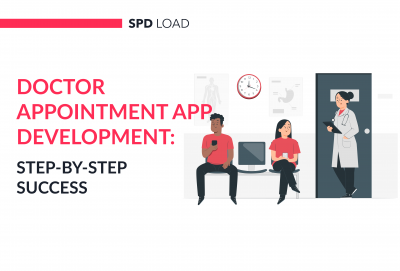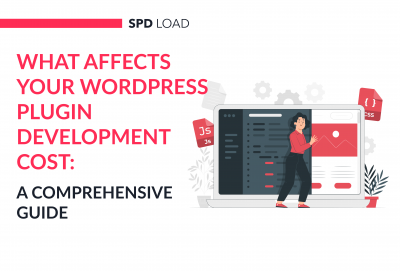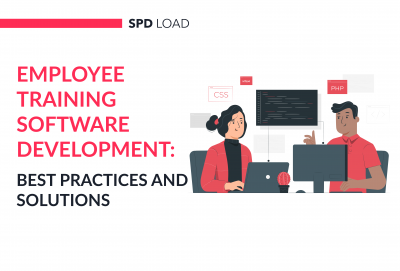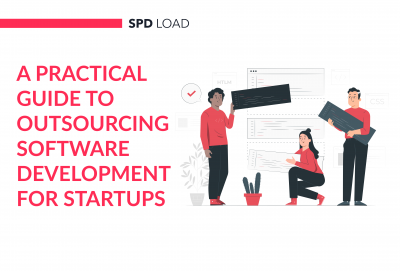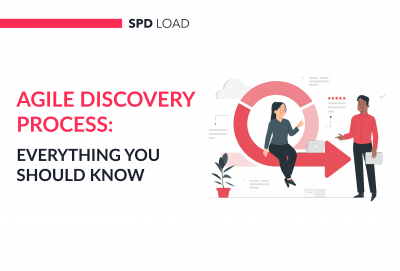Fitness App Development: A Step-by-Step Guide
- Updated: Nov 11, 2024
- 20 min
Whether you’re a founder, entrepreneur, or business owner, you need to understand how to create a fitness app.
For some, fitness is a lifestyle. Others want to get in shape to keep up appearances. Whatever the motivation, a simple mobile app now allows anyone to kickstart, continue, or accelerate their fitness journey.
But how to build a fitness app? That’s what we’ll cover in this guide.
When developing any app, two key things matter:
- The market
- The product
The market refers to the users that will engage with the product—in this case, the fitness app itself. Understanding both areas is crucial for fitness app development.
We’ll start by covering some compelling reasons to develop an in-demand fitness app for today’s market.
Next, we’ll explain the following topics:
- The business side of app building
- Types of fitness apps
- Validating app ideas
- Product discovery
- Technical build considerations
- Team structure
- Tech stack decisions
- Cost to develop an app
It can feel overwhelming, but we’re here to walk you through everything you need to know.
As fitness pros say, “Expect great things from yourself before you can achieve them.”
So settle in, leverage our experience, and learn how to build the best fitness app for your needs.
Picking the right partner is crucial — here’s how to choose an app development company that fits your needs.
Unlock your startup potential now — start transforming your vision into a scalable solution with our expert developers today!
Why Launch a Fitness App?
One of the most important and incredible reasons to launch an app is pandemic.
We empathize with the situation, but hear us out.
Before the pandemic people used to go to the gym before or after work.
But the global lockdown forced the people to arrest themselves inside their homes.
This led to a surge in taking subscriptions of the existing online fitness applications.
The World Economic Forum finds that there was a 46% increase in health and fitness apps downloaded in the pandemic across the globe.
Although there were a lot of attempts towards fitness app development before the pandemic, the lockdown gave it a push.
Now because the people were demanding a commodity, the supply has to be increased.
One of the fitness applications, Myfitnesspal bagged $6.7 million in a single month (June).
Isn’t that great?
We can see another trend here.
Before the people went to fitness applications, meditation applications also saw mass adoption.
Case in point:
- Calm meditation application earned $8.5 million in April and $7.7 million in May.
Not only this, when the lockdown shut the gym’s doors the owners went virtual.
The International Health, Racquet, and Sportsclub Association (IHRSA) states that fitness is a $34 billion industry.
This includes application, physical, and dietary organizations.
And 20% of the American people have a fitness club membership.
This is one of the reasons bigger fitness clubs went virtual.
They understood how to make a great fitness app or hired fitness app developers for the same.
This brings us to the second reason to know how to create a proficient fitness app.
Market Growth Projections and Opportunities
As per MarketWatch, the global fitness application industry will grow to $15.96 billion by 2026.
According to the report, three key drivers will contribute to this growth:
- Obesity in people
- Changing Lifestyles
- Prioritizing the health
Another market analysis platform predicts that between 2020 and 2027, the fitness app market will see a development of 21.30%.
The gym owners-turned-entrepreneurs are heavily investing in fitness application development to provide virtual classes.
Virtual fitness classes represent a successful business model.
Case in point:
- ClassPass entered the Unicorn Club ($1 Billion) after their recent $285 million funding round.
ClassPass is a studio-based fitness and wellness platform.
So, there are two things we can deduce here:
- The existing gym owners, entrepreneurs, and businessmen are looking for ways to address their audience.
- Investors are also looking for similar products to invest in because the market is bright and under demand now.
Another outstanding example is the Peloton fitness app.
Just a few days in the lockdown and the Peloton recorded a 245% increase in its memberships.
On the Business of Apps, you can see the Peloton App graph.
It went uphill like a rocket.
Within four days in March, the users of the Peloton App increased from 4000 to close to 20,000.
There is a lot of growth potential in understanding how to build an efficient fitness app.
But you should know the right method and stream ahead with a solid foundational idea.
SpdLoad comprises a team of efficient and authoritative fitness app developers.
Our flawless fitness or workout app development process is specifically curated to help you succeed.
Let’s take up the business part first before moving on to the technical aspects of how to create a profitable fitness app.
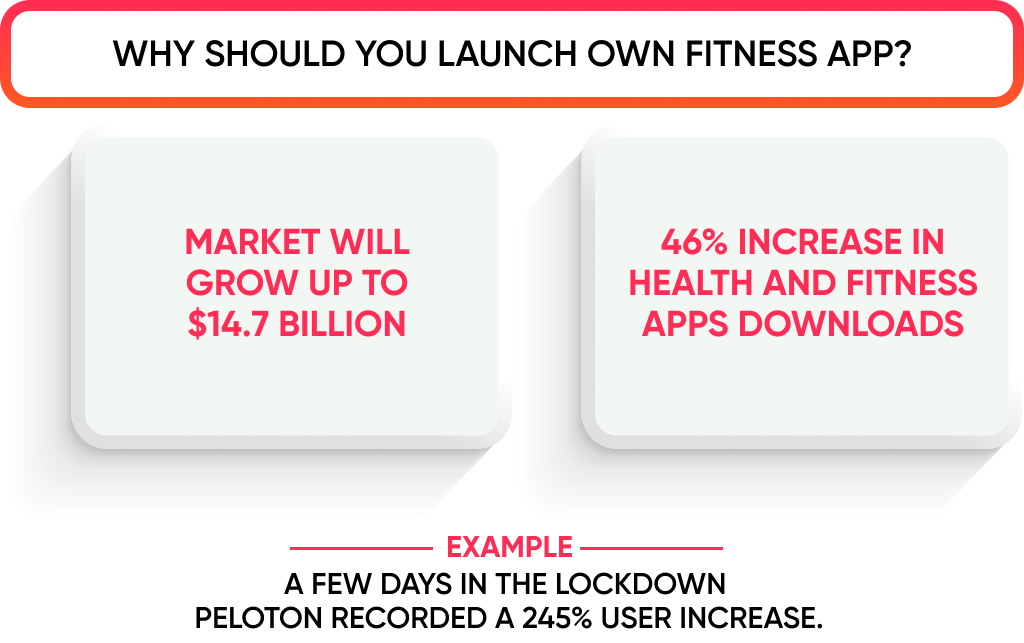
How to Create a Fitness App
A lot of things are essential to create a fitness app.
You must figure out your unique value proposition and validate your idea to check the product/market fitness.
Added to this list out the features and identify the team and the tech stack to build the same.
Crafting Custom Mobile Apps That Delight Users!
The Business Aspects of Building a Fitness App
To completely understand how to make a profitable fitness app, first, create your Unique Value Proposition.
A Unique Value Proposition comprises:
- Identification of the Target Audience
- Killer Features
- Business Model
You mustn’t skip this part.
Because the fitness application market is already saturated.
- In the first quarter of 2019, there were 37,143 health and fitness applications on Google Play Store.
That is what you will face while entering the market.
Indeed, demand has also increased. Since 2018, the number of fitness applications increased from 62.7 million to 87.4 million in 2020.
But Statista shows that 61.4 million of these users are covered by three applications.
- Fitbit
- MyFitnessPal
- S Health
Yes, in between applications like Peloton and ClassPass have outstanding performance.
But success in a saturated market depends on your unique value proposition.
Hence, you need to find out three things:
| Creating a Unique Value Proposition | How does it help? |
| Identify your Target Audience | To fully understand how to make an app for fitness define your ideal users.
Who will benefit the most from your solution? Are you targeting the office going professionals or athletes or homemakers, or kids, and so on… Create a buyer persona and then make an application that is relevant to them. |
| Killer Features | This is important.
While you build a fitness app, add a couple of killer features. The majority of the features in the MVP version of your application will be similar, one or two killer features will make a difference. To add the features, answer these questions;
|
| Business Model | Here we want you to look at the ways and means to earn and provide better outcomes.
While creating your earning strategies too, it is essential to keep the end-user in mind. Try to plan a revenue generation strategy that keeps their interest primary. The motive is not to look like a money-making scheme while providing minimal benefits to the users. |
Your value proposition is ready, and now you know what type of audience will like your application.
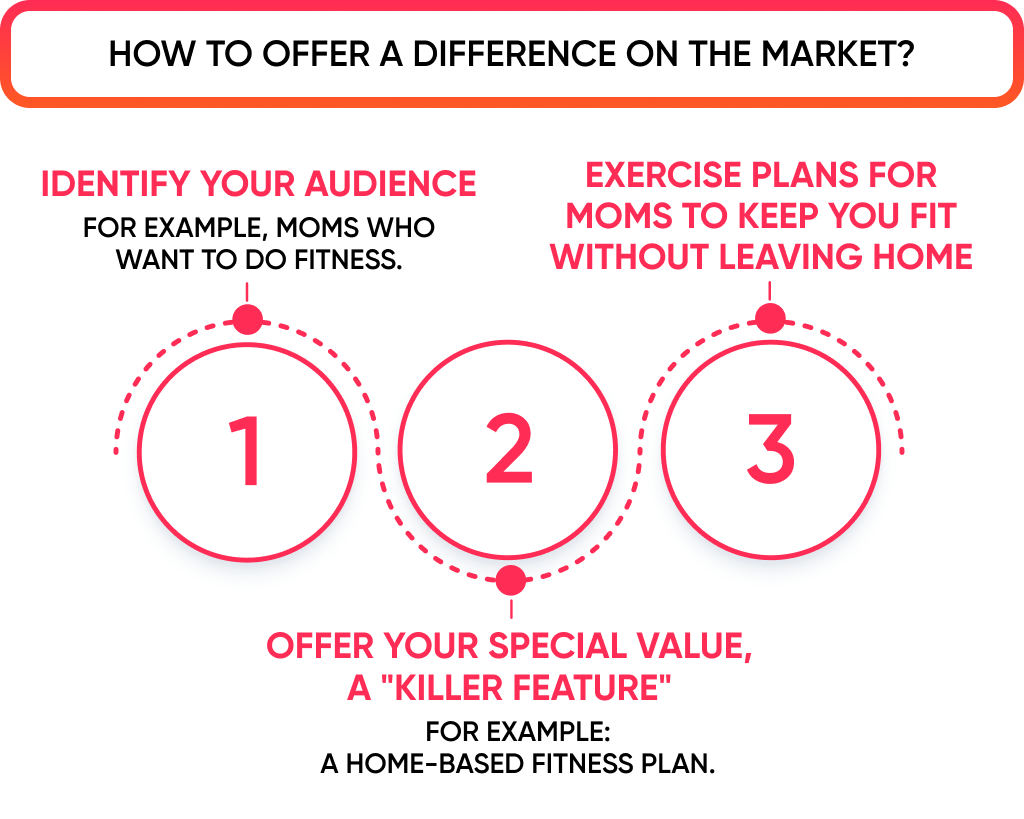
Moving ahead with how to create a user-oriented fitness app, we need to look at different fitness applications.
| Type of Application | Uniqueness and Examples |
| Activity Tracking | Activity tracking applications either cover one type of sports activity or a group of them.
You will find applications specific to cyclists, exercises, sports persons, swimming, and so on. Depending on the activity they cover, these applications record the information on the phone. |
Example:
|
|
| Workout | Knowing how to make a workout fitness app has become highly profitable in the pandemic.
These platforms imitate a step-by-step guide system to help the users work out and stay fit. There are predetermined goals and objectives that the users have to accomplish. There are methods to record the bio measurements to help create a progress chart. The exercise routines are timed, so there is an in-built alarm for the users to follow. |
Examples:
|
|
| Diet-based apps | The process to create a fitness app or a dietary application is similar.
With a few changes in the features, you will have to include similar features for all of them. The core function of diet and nutrition application is to track calorie consumption. The motive of these applications is to help control and visualize the food intake. One thing that you can add to these applications is a barcode scanner. This can help users while shopping for the right ingredients. |
| Examples:
Look at these examples to build a diet-based fitness app.
|
|
| Personal Trainer Applications | Personal training apps are exactly like what they sound.
These applications create a custom plan for the user and help them train. It is important to personalize these applications. You need to add features and functions that will help the user understand;
Plus, they need to have adaptive learning capabilities. This sort of technology will help utilize the application to its full potential. |
Examples:
|
So far in our guide on how to make a fitness app, you have got the target audience and the type of application.
The next step in fitness app development is to answer another important question.
Do They Fit Together? Idea Validation
‘They’ implies:
- Your target audience
- Type of fitness app you want to build
For this, we recommend validating your idea.
Our fitness application developers have achieved proficiency in idea validation.
They will take the idea to generate honest feedback and then launch your application.
This way, we minimize the bounce rate while creating a user-specific solution.
Here is what goes under idea validation while you learn how to create a fitness or workout app.
| What To Do? | How Does it Help? |
| Create Landing Pages | Landing pages are one of the most effective ways to understand the market pulse.
Before you build a workout or fitness app, a landing page helps collect feedback on your value proposition. List application features and share them on various platforms and running ads on the same. You can build landing pages with online website builders. |
| Create Wireframes | Wireframes are instrumental in helping the fitness app developers understand the steps.
These are a form of digital prototypes that layout every step a user will go through while engaging with the application. |
| Collect Feedback from the Target Audience | The landing pages help gather feedback from the audience while the wireframes are essential for user experience.
Both these developments in how to make a market-ready fitness app must go in a loop. This means that once you publish the landing and create wireframes to collect the feedback, enroll the feedback in the development process. |
By following this lean approach in app development for fitness you:
- Knock out the aspects that are not beneficial or appreciated by the audience.
We want you to look at four things in idea validation:
- Social Acceptability of your application
- Compatibility of your idea
- The relative advantage of the features you are offering
- The complexity of the product or solution
It does not matter how relevant your solution is to the world – it needs validation.
So, you test, track the results, and implement the changes.
This is a low-cost method that runs in loops until and unless you have a functional concept.
Until this point, the process to build a great fitness app was not concretized.
But, we will do so based on the best project discovery phase practices.
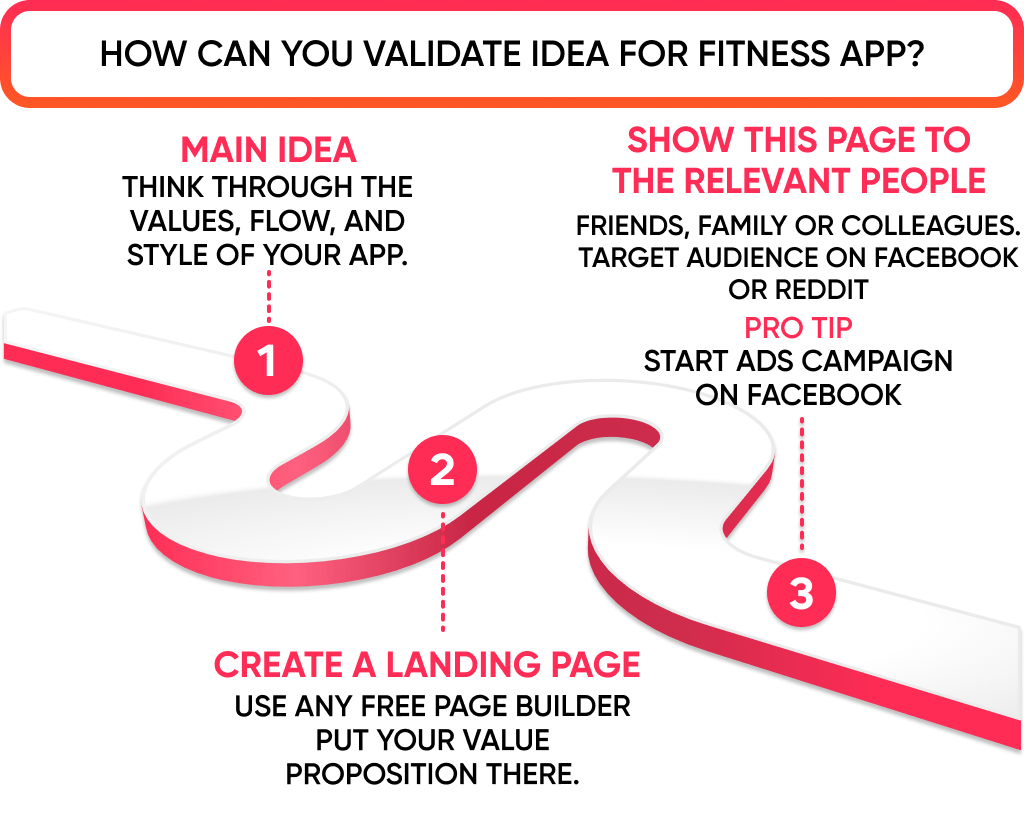
Discovery Workshop
Idea Validation answers the “What” for fitness app developers.
Discovery workshop answers the “How” and “Why” in how to make a great fitness app.
Under this, the team will carefully cut through the idea and conduct deep analysis.
The motive is:
- Identify product requirements
- Know the technical aspects
We can also use this opportunity to check the monetary-worth of the idea.
The motive of a discovery workshop is to unite three things:
- Founder’s vision
- Market requirements
- The development team and tech stack
Within the fitness app and solution development, the motive of the discovery workshop is to amalgamate the core idea behind the app, how it will help the users, and how will the founder benefit.
In how to create a successful app, discovery workshops help determine why a person wants to create an application.
MyFitnessPal’s founder Mike Lee, created the application to track his and his wife’s meals and snacks.
At the time of its creation, Mike did not find any working solution to help with his problem.
So, he invented a solution and today MyFitnessPal is one of the best fitness applications.
That is what you need to understand in the discovery workshop.
Why do you want to build a solution?
Already the fitness app market is flooded.
The web of applications at the user’s perusal makes choosing their ideal application difficult.
Hence, it is your job to convince them why they should use your application.
Lastly, create a framework for earning revenue. Because we also need to identify how the founder will earn revenue from the application.
The different options you can consider include:
- Subscriptions
- Memberships
- In-app purchases
- Advertisements
This was all about the business side of how to make a fitness app.
Once you have covered this, start with the technical aspects of fitness or sports app development.
Technical Considerations for Building a Fitness App
Always keep two things in mind while you build an exercise or fitness app:
- Create a solution that makes people come back again and again.
- Always be prepared to scale your application on-demand.
To fulfill these aspects, you need to select the right set of features for the application.
With this in mind, let’s know the features of how to create an MVP fitness app.
Initially, focus on creating a basic version of what you might call the MVP version of the application.
An MVP helps save costs, time, and resources.
Plus, when you launch the MVP version first, it helps understand the user’s response.
This allows making relevant changes during the initial stages and conforms to the user’s response.
So, here are the MVP version features to know when you create a fitness app.
Core Features
| Feature | Importance and Hours Required |
| Sign in and Sign up | With this feature, you allow the users to create an account and start using the application.
For better engagement, ensure that the users can sign up with Google, Facebook, Twitter, or other email accounts. Aim for one-click login and sign in.
|
| Role System | For applications that provide multiple roles like a swimmer, cyclist, runner, sports person, and so on, embed the role-specific framework.
You can combine this option with the profile creation. The fitness application developers need to be informed earlier about the number of roles an application can play. In any kind of application, a role system is imperative. This creates a high-engagement platform. For instance, a diet tracking application can help the user choose from different roles pertaining to their physique, food preferences, and daily routine. Following the choice of the role, the user will engage with the relevant interface.
|
| Personal Profile | When you build the fitness app, it is important to let the user create, edit, and manage personal profiles.
Another benefit of creating profiles is saving user data. So, even if the user wishes to take a break from the workout or any sort of routine, their data will be safe within the application.
|
| User Activity Tracking | Activity tracking can take many shapes and forms.
Beginning from tracking the footsteps to counting the calories and number of reps of the exercise. Once you have all this information, you can calculate your calorie deficit and adjust your diet and exercise accordingly to reach your fitness goals. We can tweak tracking settings to allow the user to get detailed information. Either you can choose to use the Google Fit or Apple HealthKit API for this purpose. Or find fitness app developers to create unique tracking systems for your solution’s development. In the former case, the cost and time will be less than the latter. Another important aspect here to add gamification features. Gamifying means that you are creating a better visual user experience. With transitions, character-based tracking systems, and animations, the user will be able to track their achievements with a better perspective.
|
| 3rd Party Integrations | A tracking application has to have compatibility with the popular wearables.
From watches to dedicated trackers, your application should connect with them via Wi-Fi or Bluetooth. The motive to add this in your itinerary of how to create a future-ready fitness app is user engagement. Since you cannot decide which wearable your user will work with, you need to prepare an application that works with them all. Here, you can also partner up with a wearable brand and get exclusive support. Another way to look at this is that your users will want to accumulate all the data in one place. So, integration with systems like Samsung Health can also help build better engagement.
|
| Notifications | Out of all the applications we have built, we feel that notifications are most important in fitness applications.
Because fitness is different. This is not something like from “not checking a friend’s new post,” or “missing out on a shopping deal.” Fitness requires consistency. Hence, by sending reminders for;
And much more. Hence, notifications have a special purpose in fitness application development.
|
| Total Hours: | 600 hours |
These are the basic or you can say core features to know when you create a simple fitness app.
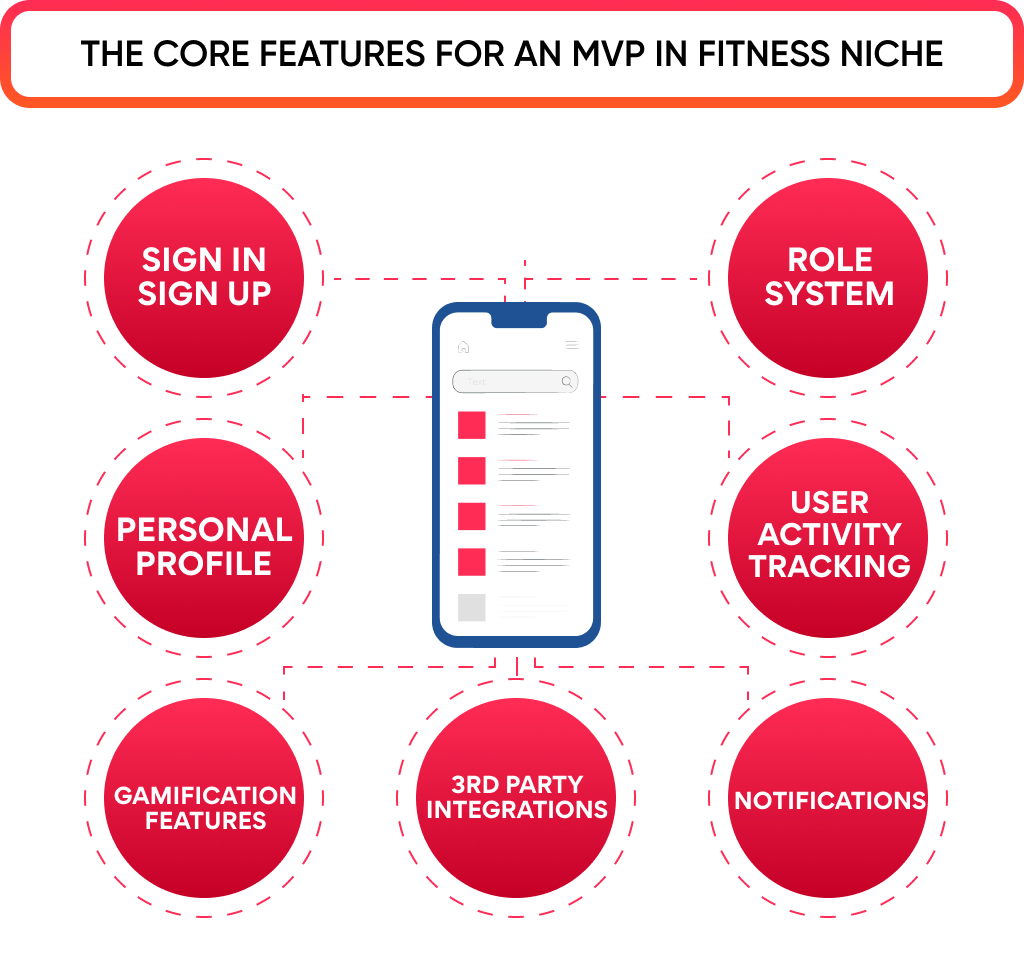
Moving on with how to make a successful fitness app, we also need to know the advanced features.
But why do we insist on separating the features into MVP and Advanced?
There are many reasons for it:
- These features add to the application’s complexity.
- They take time to build and can lead to a steep learning curve.
- Adding them in the first go can increase the cost and reduce the ROI.
- You will need more than 2 dedicated fitness or workout app developers to add them.
- They also require regular maintenance and support for which you might not be ready at the initial stages.
Listed below are the advanced features you should know for how to create a sophisticated fitness app.
Advanced Features
| Advanced Features | Importance and Hours Required |
| Internet of Things (IoT) | IoT will provide a major boost to your application to create a personalized experience.
Not only exercise, but by adding the IoT concepts you can change personal health, workouts, and sports tracking, recommendations, and activity. IoT will help collect individual-specific data, store it, analyze the readings, and provide relevant recommendations. Added to this, you can also create an immersive training experience with IoT embedded into the system. Remember the Peloton example? Well, when you are looking for answers for fitness app development, Peloton is capitalizing on the IoT technology wonderfully. Peloton Home Bikes are now available for individual sale, and the additional membership will create a gym-like experience at home.
|
| Geolocation | Geolocation is an essential aspect of the process to build an advanced fitness app.
It helps track the daily walk, cycle, or jogging route. Plus, you can also allow your users to select or create a dedicated route for their exercise. With geolocation, the users can also check the number of kilometers they have run. You must have seen several people sharing their route maps with red lines marked all over the screen. Those red lines mark the route a user has taken to run or cycle. Added to this, it is also important to provide information like elevation, speed, and time taken to enhance information sharing.
|
| Library of Workout Plans | This is what you can call a library of audio and video workout tutorials.
Such a feature becomes more important for workout fitness or workout app development. Adding videos of how to do different types of workout exercises can help the users learn the right way to workout. In other sorts of fitness apps, you can build a library of engaging and informative content. Diet based applications can have recipe videos or product explainer videos.
|
| Social Media Integration | Social media integrations allow users to share their progress on their handles.
This is good for you because;
|
| Total Hours (MVP + Advanced features) | 920 Hours |
That is all you should not know about the features of how to make an advanced fitness app.
It is not essential that you have to add all sorts of advanced features.
The correct group of functions and features can depend on the kind of fitness app you develop.
Now that you have the features list ready, it’s time to get your team together.
Optimize Your Development Lifecycle with DevOps Experts.
Team Composition
Moving on with how to create the best fitness app, we will form the dream team.
The team composition you will read below is for the core version of the application.
The strength of your team will also contribute to the cost estimation of fitness or diet-based app development.
To build a fitness app, you need:
- Project Manager (1)
- Business Analyst (1)
- Front End Developer (1)
- Back End Developer (1)
- Quality Assurance (1)
- UI/UX Designer (1)
Once you know the roles, choosing the right people for your team is also essential.
Remember that you should not look for the perfect developer or designer, but the right person for the job.
At SpdLoad, we recommend you using our CEC Approach.
CEC means Communication, Experience, and Cost.
The right mix of these three concepts will help you select the right person or team for the job.
| Concept | Importance |
| Communication | Communication does not imply how the team personnel talks, but it is an umbrella term.
Communication implies:
|
| Experience | You need experienced fitness application developers, no doubt.
But, apart from experience, it is important to look for:
|
| Cost | Keep one thing in mind while choosing a reliable partner from the cost perspective.
“Expensive does not always mean Good.” So, when you come across a developer who charges $200 per hour, we expect him or her to be a master of their art. But this may not be true. Yes, good and experienced developers will provide a better product. But apart from cost alone, factor in other aspects too. This includes:
|
So, now that you have your team ready and also understand how to choose the team to build a standard fitness app, it leaves us with the tech stack.
We figure out the technical stack for the application during the discovery phase.
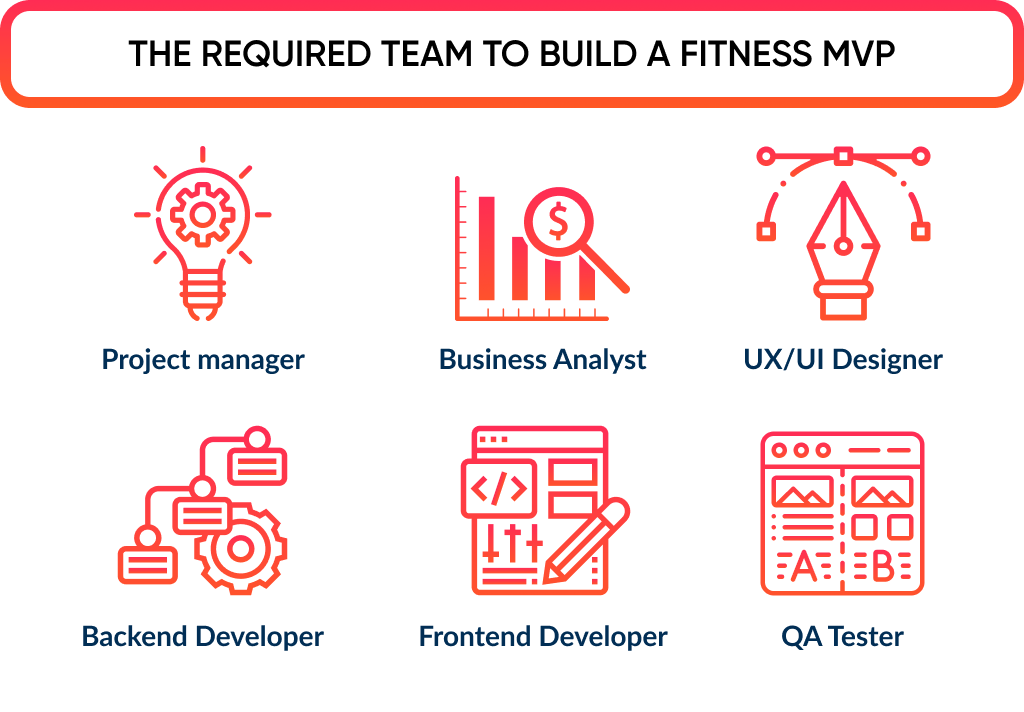
Tech Stack to Create a Fitness App
| Function | Technology and Benefit |
| Project Requirements | Use G-Suite to jot down all the project requirements in a single shareable document. |
| Prototyping and Design | Figma helps in creating code-less prototypes and real-life design that include HTML and media dimensions for easy handoff. |
| Hosting Service | We recommend using AWS for hosting needs.
AWS is easy to use, implement, and provide a diverse array of tools. Compare Digital Ocean, AWS, and Google Cloud for insights into which platform fits your business best. Wondering how to choose the best hosting for your SaaS platform? This article on hosting for SaaS can help. |
| Backend | With features like out-of-box configuration and easy authentication implementation, Laravel is the best choice for backend development. If you’re working with Laravel, these best Laravel tools and resources will streamline your workflow. |
| Frontend Development | Due to the cut-throat competition in the market, you need to create a better fitness app fast with extensibility and flexibility.
React.Js can deliver these benefits while enhancing performance and usability. Discover the cost to hire a React.js developer and learn what you can expect for your investment. |
| 3rd Party Integration | Using the relevant 3rd Party for fitness app development is essential.
For Maps, use Google or Apple Maps. Payment Integrations can be done via PayPal or Stripe. |
| Testing | It is better to use Selenium as it supports several languages and frameworks.
Added to this, you can also benefit from the reusability and ease of implementation. |
In our experience, this tech stack will provide the fastest market-ready product while ensuring authenticity and proficiency.
At the end of the team selection to create an efficient fitness app, you will have a solid foundation for your solution.
Now we are left with the cost to build your fitness app.
If you are wondering how much it costs to make a fitness app, then follow the next part.
What’s the Cost of Fitness App Development?
There is no straight answer to this question.
Several factors come into play when you talk about the costs.
To name a few:
- Types of features
- Complexity of design
- Application size
- Type of team
- Number of features
So on and so forth…
Except for the type of team, all the aspects are related to increasing the number of hours.
For instance, a complex application design will take more time to be ready as compared to an application that has a simple design.
Similarly, sophisticated features require more manpower and hours.
Design is key to user engagement. Learn more about the app design process and its importance for app success.
Ergo, as you keep on adding the features and keep on twisting their implementation, the cost will rise.
That is why it is not easy to give a straight answer to how much it costs to create a profitable fitness app.
However, to take the discussion forward, let’s assume that the total number of hours to create a fitness app is 880.
| Development Step | Hours Required |
| Documentation, Validation, Discovery | 40 |
| UI/UX Design | 80 |
| Development | 600 |
| Project management | 80 |
| Testing and QA | 80 |
| Total Hours | 880 |
Now, the next essential part is the type of team you choose.
You have three options:
- Hire freelancers
- Hire an in-house team
- Outsource the work
Out of these three options:
- Choosing freelancers is the most cost-efficient method, but they are not reliable and the management of the entire team of freelancers sparsely located across the globe becomes a nuisance. The average cost to hire a freelancer is $25 per hour.
- If you choose to go ahead and hire an in-house team of fitness app designers and developers, expect to receive a great application. An in-house team is easy to manage and there is no communication gap. The entire team will work on a single floor and there will be complete understanding between the designers and developers. However, hiring an in-house will cost you around $150 per hour.
- The third option is to outsource the work to an agency outside of the US.First and foremost, you will get access to an equally efficient team of fitness app developers and designers as you will get in the country. Second, the outsourced agencies in Ukraine have an average hourly rate of $35. This means that you will get the best digital solution at a fraction of the cost you may have to pay in the US. Learn about the best countries to outsource software development to get high-quality results.
Based on these hourly rates:
- Working with freelancers, the cost to build a working fitness app will be $22, 000
- With a US-based agency, the cost will be $132, 000
- The cost of fitness application development when you hire a Ukraine-based agency is $30, 800
Ergo, you stand to gain with outsourcing the work.
Now you know how to make a fitness app.
Not only this, but you also know who will be your ideal partner to create your fitness app.
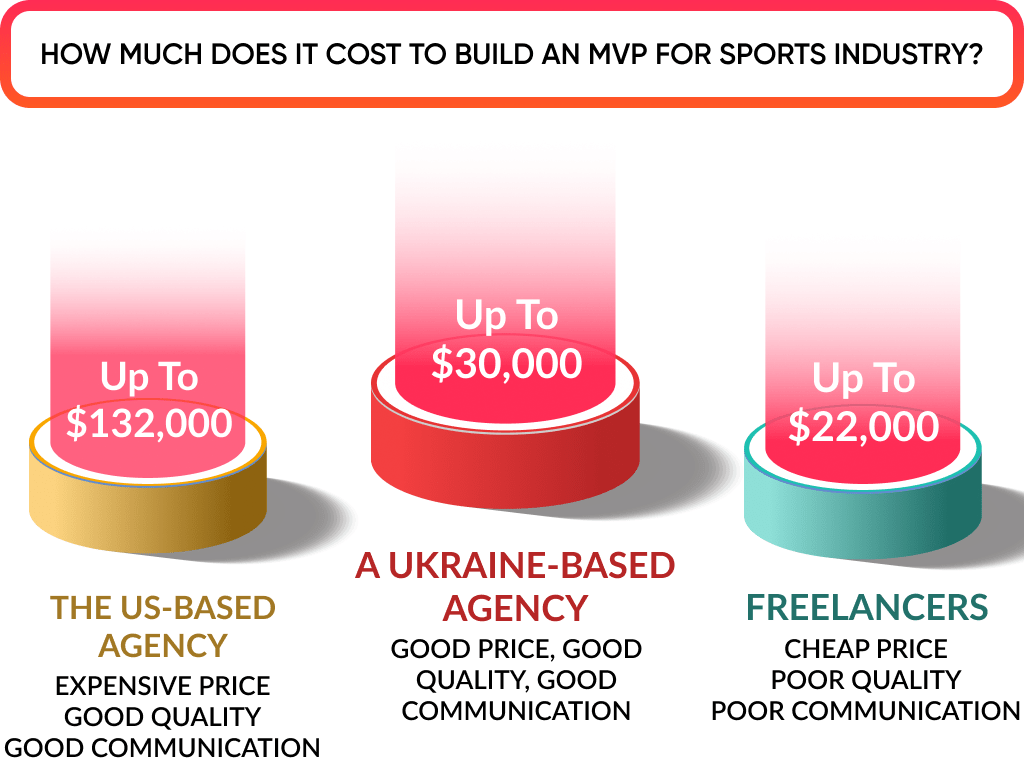
Looking for a Partner to Build Your Fitness App?
Let me share an example from our experience building fitness apps.
Recently, we developed a fitness application for athletes. It was one of the best projects the SpdLoad team has completed by harnessing collective intelligence.
The client required:
- A valuable app for athletes
- Access workouts anytime, anywhere
- A library of pre-recorded workout videos
- Real-time streaming with coaches
- Gamification to set and track goals
After understanding these needs, we created a draft and proof of concept and used our discovery workshop to build the solution.
Since the founder was non-technical, we carefully explained each step so he could create an incredible, future-ready startup from the ground up.
The SpdLoad team spent 1,200 hours developing the Get Reinvented app. Today, it provides customized HIIT programs to users.
We were instrumental in making this founder’s vision a success.
At SpdLoad, we go the extra mile on all digital solutions—not just fitness apps. We identify market gaps and then engineer the perfect product to address consumer needs. That’s why our work succeeds.
Have an idea you want to bring to life?
Our expertise turns visions into real-world solutions. Get in touch and set up a consultation to start building your app today!



